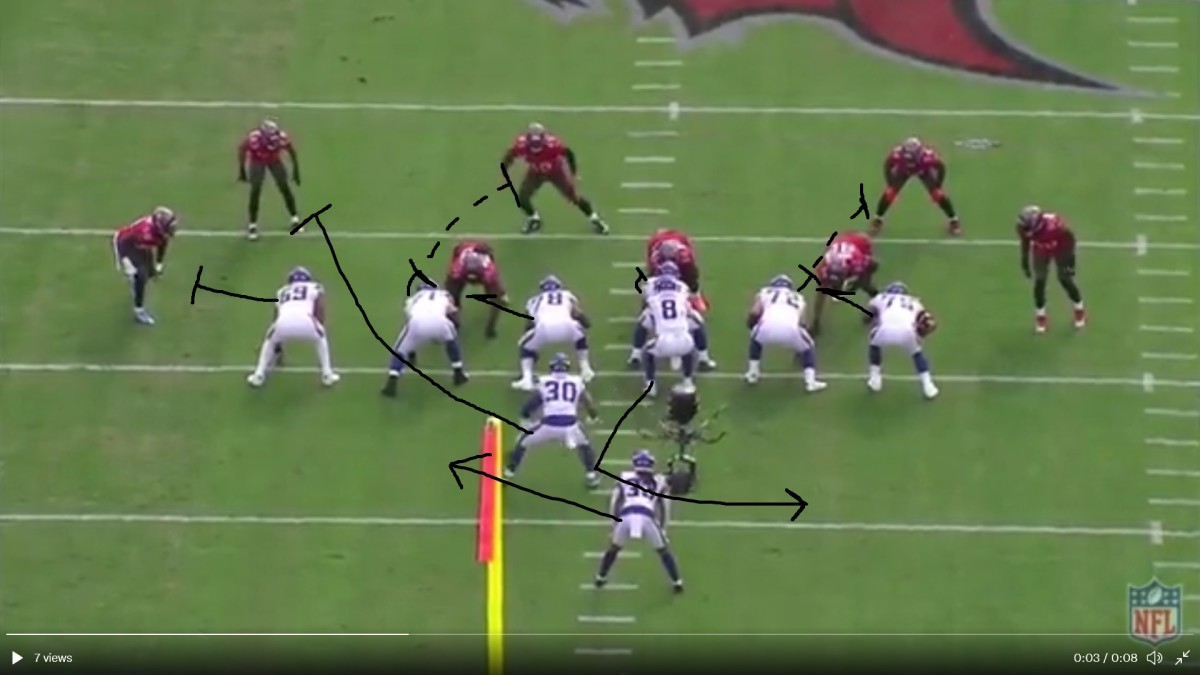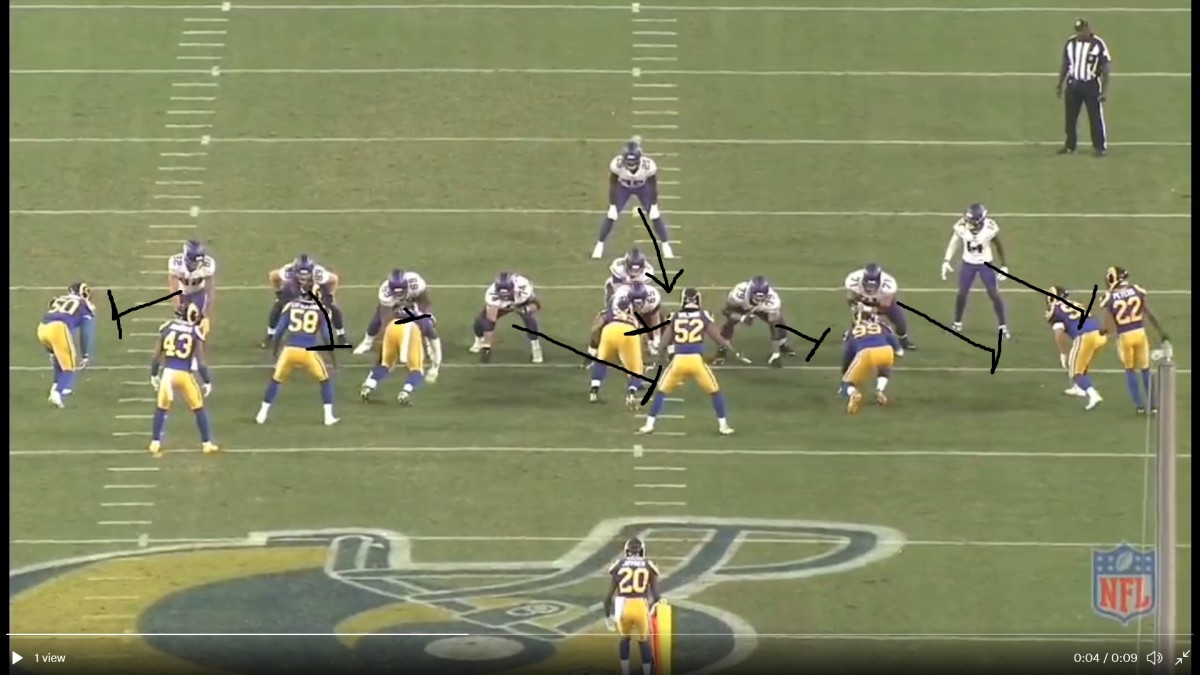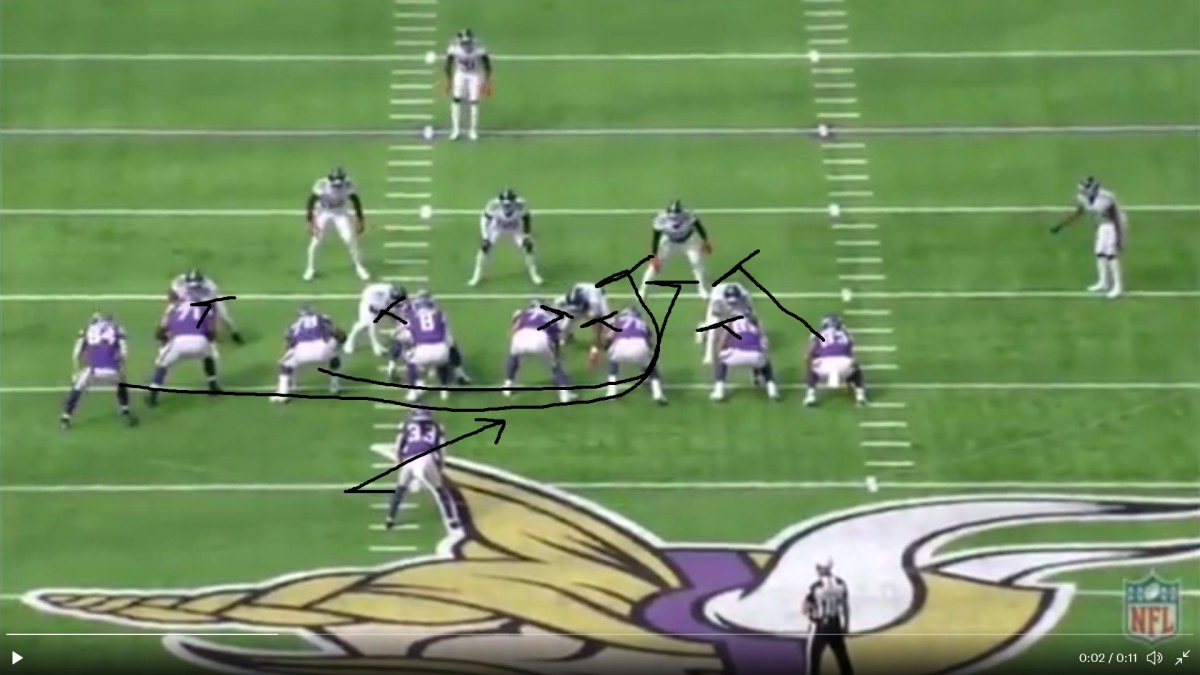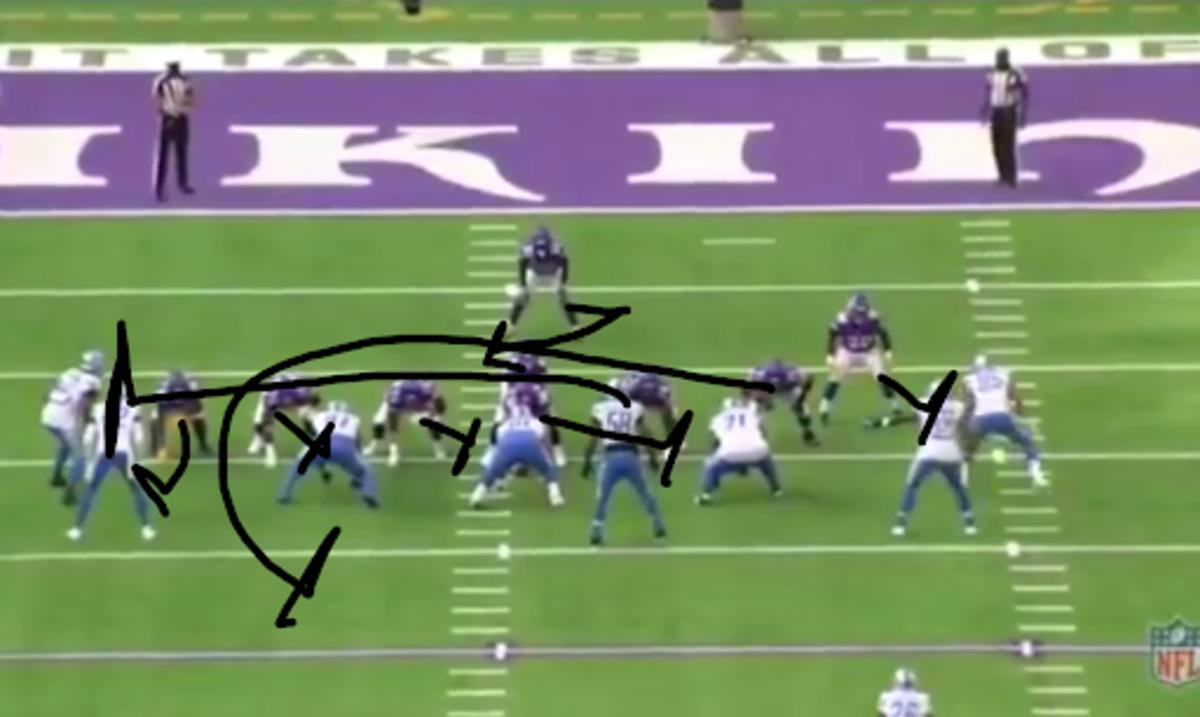Film Breakdown: A Schematic and Personnel Preview of the Minnesota Vikings' Offense
The Bengals will host a familiar face on Sunday as Mike Zimmer returns to Paul Brown Stadium for the first time since he was the defensive coordinator.
Zimmer was hired by Minnesota in 2014. It feels like that was the beginning of a connection between the Bengals and Vikings. Not just with their shared former coach, but players have left Cincinnati and joined Minnesota, including Terrance Newman, George Iloka, and most recently Nick Vigil. They also carry a few former Bengals coaches (other than Zimmer) headlined by Paul Guenther. Even though fans are probably somewhat familiar with this team due to all of this, let’s have some fun and deep dive into this Vikings team to become familiar with their scheme and personnel.
The Kubiak Wide Zone Offense
If you have been following my writing over the past couple of months, seeing the “wide zone offense” as a section title shouldn't be a surprise.
While the Vikings run a wide zone offense, it is more of a cousin rather than a brother to the Bengals/Rams type of wide zone offense. Their wide zone comes from Gary Kubiak, who was one of the three Godfathers of the wide zone offense. He perfected the offense in Denver with Alex Gibbs and Mike Shanahan. Even though Kubiak stepped down and retired after last year, the Vikings offense is still run by a Kubiak. The new offensive coordinator is Gary’s son, Klint Kubiak.
There is one easy identification for why these offenses are so different to me. Last year the Bengals led the entire NFL in 11 personnel (76%), while the Vikings are dead last in 11 personnel usage (29%). With that being the largest distinction between the two, they still are similar offenses. They both feature the same run concept in the wide zone and some of the same counters off of that concept.
Upfront, the offensive line is displacing the front horizontally with the halfback reading the end man for his bang, bend, or bounce based on his leverage and the other defenders. The aiming point for the running back is still to the butt of the tight end (or where the tight end would be if it is run to the open side).
The high usage of a fullback by Minnesota is different from Cincinnati's wide zone. The fullback will typically run the path of the running back and block the first threat that appears. For the defense, this essentially creates another gap similar to the effect of a puller. They still utilize the one back wide zone variation as well from 11 and 12 personnel, and that run is very similar to what the Bengals use. If you want to learn just about everything you need to know about one back wide zone, check out my article on it here.
Let's go over the two back lead wide zone.
— Mike (@mike_sans_NFL) August 31, 2021
The Vikings come out in an I-formation with what looks like an extra offensive lineman to the left side. Right before the snap, Kirk Cousins motions the fullback, C.J. Ham, to an offset position towards the tight end.

You can see from the blocking diagram I have given that the Vikings can block their wide zone tighter than the Bengals or Rams because of the fullback inserting to the SAM linebacker. Normally that would be the left tackles job to get to the SAM, but instead, he gets to combo the 3-tech to the MIKE [linebacker]. It has a domino effect down the entire offensive line. All of them get to keep their blocks and combos tighter with the fullback taking on the strong side linebacker.
Dalvin Cook does a very nice job to set up his blocks behind the line as well. He gives a little hesitation and stops right at the nose tackle to hold him, then he continues working outside. His cut upfield is a little high stepping gallop which keeps his feet clean from an ankle tackle and gets him exploding upfield. He stumbles and trips, but it is still a very nice gain. The Bengals will see a lot of this on Sunday.
Run Counters to Wide Zone
The Vikings have multiple run counters to their wide zone, but I am going to go over the two that I saw the most frequently on film, tight zone and GY counter.
— Mike (@mike_sans_NFL) September 2, 2021
This is tight zone, which is similar to inside zone, but the path for the RB is towards the A gap rather than the B gap. Other than that a lot of the blocking rules are similar with a drop step towards the play side and then working to displace in the same direction to the play side.

The interesting thing about this play is that there are no combos or double teams. Somewhat due to the front shown by the Rams here, but also because in the tight zone it hits quicker than the wide zone or even inside zone, so the blocks have to happen quicker. Unlike duo which has a similar path, the tight zone does not involve the running back making the MIKE linebacker wrong. His read starts with the playside A gap and works his next read off the leverage there. Rashod Hill (more on him later) has issues blocking this play which throws a wrench into it, but I still think that it is a good example of the tight zone that the Vikings utilize.
Of course, the Vikings also carry a two back variation of tight zone as well so they can utilize their talented fullback.
— Mike (@mike_sans_NFL) September 3, 2021
The main difference between one back tight zone and two back tight zone is that the fullback will insert through the A gap and take the MIKE linebacker on two back tight zone. In one back tight zone there is no one to insert, so someone on the line of scrimmage has to take the linebacker. That’s pretty similar to the difference between one and two back wide zone as well.
There are no double teams on this tight zone either and while those combos do still sometimes occur in tight zone they are not as common as in wide zone or even inside zone. The main reason for changing things up with tight zone is to attack a team that flows too hard or really sets themselves up for wide zone. It hits quicker and tighter so it's less similar to a change-up and more like a fastball theoretically. Hitting quick and fast before the defense reacts in time because they're sitting on the wide zone.
The other run play the Bengals need to prepare for is the counter. This is a gap concept that is mixed in with the Vikings zone scheme. One of the main differences between gap and zone is that rather than quick combos from offensive linemen, you get more true double teams where neither guy is coming off to a linebacker. Another difference is that gap concepts are more about displacing guys vertically rather than horizontally. Those two points combine to give you the "what" (true doubles not combos) and the "why" (push vertically rather than horizontally).
— Mike (@mike_sans_NFL) September 3, 2021
This specifically is a GY counter. The GY stands for who is pulling, so here it is the guard (G) and tight end (Y).

Now watch this play as the guard and tackle both work together to move the 3-technique with neither guy leaving. The guard is going to pull around that double team and block the first guy to show up while the tight end will pull behind him and block the next guy in the second level to show. The false step from the running back serves two purposes. It holds defenders keying him as he steps opposite of the flow and it gives the blocks time to set up. The play works extremely well here as the blocks start to form before Cook even begins his work. He does help his blocks on this play as he slams down and stops on two feet getting one of the linebackers to show his leverage to the inside. This lets Cook cut outside and then show his good speed as he sprints into the end zone.
It's not just GY counter that the Bengals need to look out for though.
Vikings mix up their Kubiak wide zone scheme with some GT and GY counter from time to time. Good way to attack teams that get into a bear front to stop it. pic.twitter.com/mc1N2hHNJ0
— mike (@bengals_sans) September 3, 2021
Here is GT counter, which is similar to GY but with the tackle pulling rather than the tight end. It's pretty easy nomenclature with G for guard and T for tackle, but that shows why you don't label tight ends with a T.

Another difference here is that instead of leading through the second level the guard is kicking out the end. Mostly everything else is the same with a false step from the halfback, the second puller still pulls to the linebacker, although there are no true doubles on this play. This is a nice way to attack a team that gets into the bear front to stop the Vikings wide zone in my opinion. The bear front limits the number of double teams that can be executed on wide zone by having a guy there for every interior player. The problem with it is that other than the center, it makes for easy blocks on a play like GT counter, so if those guys can seal the interior it creates two extra gaps to the playside. That's tough on the linebackers to deal with when there are only two of them.
However, these two run concepts are not the only plays that the Vikings utilize to counter off their wide zone.
Bootlegs
Every wide zone team carries bootlegs as one of their staple concepts. It works the second level defenders like a charm. You fake the wide zone one way to get them flowing in that direction and then have plenty of open grass to throw to in the other direction.
— Mike (@mike_sans_NFL) September 2, 2021
Related: Read More Film Breakdowns Here
On this play, the Vikings are going to utilize their quarterbacks strengths and show a common look. It's split flow from them with the fullback working across the formation and everything else is showing wide zone. You can see all of the linebackers flowing to the wide zone side and moving downfield to stop the run. It perfectly sets up Ham on the slide route working the other way with room to run. As I also mentioned, this play specifically utilizes Cousins to the best of his abilities. He gives a good hard play action fake and then rolls left. Not every quarterback is comfortable throwing while rolling to their left, but it is something that Cousins does well. Just a small throw to the slide route, but he has to also be able to hit the over route if the defense cheats it, which he can.
— Mike (@mike_sans_NFL) September 3, 2021
Here is an example of Cousins not just hitting the over route, but hitting the deep ball on a boot to the left. A very impressive throw and something to be prepared for on Sunday.
— Mike (@mike_sans_NFL) September 2, 2021
This play is another example of a boot or naked with a slide route underneath. The interesting thing about this play specifically was utilizing Stefon Diggs on the slide rather than one of their big bodies like Ham, Rudolph, or Smith. The Rams do a nice job of taking away all of the routes, but eventually, the defender has to choose between letting Cousins scramble versus letting Diggs try to make a catch on the sideline. It's smart for the Vikings to utilize their wide receivers on these slide routes because they motion their wide receivers tight to the line on run plays fairly often. By utilizing the wide receivers on the slide route it gets a more athletic player into space while still having the ability to be packaged with run plays from that formation and motion.
Dalvin Cook
Now that we have looked at a few of the concepts the Vikings run, it is time to look at a few of the key players in this matchup starting with star running back Dalvin Cook. I have already given a small look into him from the run plays, but I think he deserves a full deep dive as one of the best players on the Vikings.
Dalvin Cook is that dude. I hope our linebackers are ready for contact week 1! pic.twitter.com/3E2OeqQkwQ
— mike (@bengals_sans) September 3, 2021
One of the first things that jumps off his film is how physical he plays despite being below average in size. Look at how he lowers his shoulder into Deion Jones (a very good linebacker) to gain extra yardage on this play. While he is not afraid of making contact, he is not just a power back. In fact, I think his elusiveness is probably the most frightening part of playing against him.
— Mike (@mike_sans_NFL) September 3, 2021
Here was probably the most impressive play that I saw from Cook in terms of his elusiveness. He makes four guys miss with subtle movements, jukes, and finally a spin move. One of the things that goes a little bit more under the radar with him is how talented he is at getting his feet out of the way of the defender’s arms. You can see here that he does a little high stepping to avoid hands swiping at his ankles.
The elusiveness is off the charts. It’s almost like Cook greases himself up in oil before every run with the way defenders just fall off of him. Defenders need to tackle with more than just an attempt with their arms. He runs right through those types of tackles, but you also cannot just try to lower a shoulder into him because he has the balance to stay upright and on his feet. Both the defender’s body and their arms need to be involved in every tackle. Wrap up the legs to kill the engine while driving enough force into him to bring him to the ground.
— Mike (@mike_sans_NFL) September 3, 2021
Cook ran a 4.50 40 yard dash at the combine, but he's faster that that in the game. Watch on this play as he breaks away from the defense starting from 60 yards away. From that point on it is essentially just a foot race to the end zone. Cook wins that race by quite a bit, which proves that he may be faster than that time showed. He has home run potential on every play.
— Mike (@mike_sans_NFL) September 3, 2021
Lastly, let us take a look at Cook’s receiving ability. He is not an Alvin Kamara [or Chris Evans] type that can be split out wide to run a slot fade, but he has great hands and the ability to adjust to the ball in the air. You can see both of those things show up on this play where he adjusts to a ball thrown behind him. You can combine his ability to catch the ball with the elusiveness and home run potential to see how he can be a problem in the passing game.
Cook is going to be an issue for every team he plays against. When it comes to the Bengals specifically I think that Cook is going to give the linebackers some issues. Whether it is on the ground or through the air, he will look to replicate what Nick Chubb did to the Bengals in Week 2 of last season when he broke a ton of tackles and got to the third level for chunk gains. Cook certainly has the ability to do so, which means the young linebackers have to be ready to take him on.
A Dangerous Wide Receiver Duo
Not only do the Minnesota Vikings carry one of the best running backs in the league, but they also have one of the best wide receiver duos in the league in Justin Jefferson and Adam Thielen. They have some similar traits. They're both shifty and talented route runners that can move all across the formation. Let’s look at each one of them in depth to see just how they play.
— Mike (@mike_sans_NFL) September 4, 2021
The thing with Jefferson is just how different he moves compared to many wide receivers. Watch here how he uses a fake step to the outside at the top of this route before he breaks it back inside. Not only is it impressive how he makes that fake, but also look just how wide that false step is. It’s like a eurostep in basketball with just how hard of a fake he gives. Not only that but he can push and change direction off of that false step to explode in the opposite direction.
— Mike (@mike_sans_NFL) September 4, 2021
More fakes and shiftiness with Jefferson’s route running. Here he gives a quick fake of a hitch route to get the cornerback to bite. He does this with not just his feet and body, but also his eyes. Once the corner bites on the fake he explodes vertically to create separation down the field.
— Mike (@mike_sans_NFL) September 4, 2021
Jefferson's at the bottom of the screen on this play running some type of fake over route that turns into a corner. He starts this route by squaring up his feet and giving a fake to the outside to get the corner onto his heels. Once he gets the corner uncomfortable, he begins his route by running away from the corner to the inside. The cornerback is going to fight his hardest to stop the over route and ends up overcommitting to it. Then, Jefferson can completely change direction in just three steps. The corner does not stand a chance at this point and gives up the touchdown.
— Mike (@mike_sans_NFL) September 4, 2021
This is just another example of how funky he moves when running routes. He gives those fake inside and outside steps on this route to sell the vertical component. After he pushes vertically, he slams down and turns around to catch the comeback. All of his movements horizontally and vertically sold the route well as the corner thought that this would be a vertical route of some sort. He is on his heels opening his hips vertically while Jefferson is turning around.
— Mike (@mike_sans_NFL) September 4, 2021
Lastly, I wanted to specifically go over this fake step that Jefferson uses here and in previous clips. This fake at the top of the route is called a rocker step and it is something that Jefferson excels at using. It’s basically shifting all of your weight to one step for a fake and then pushing off of that foot to explode in the opposite direction quickly.
Now that we have finished a breakdown of the younger, more explosive receiver, let’s dive into some film of the older more experienced wide-out.
Adam Thielen with a pretty sexy squirrel route pic.twitter.com/9PAn0e519t
— mike (@bengals_sans) September 2, 2021
In this play, Thielen runs a squirrel route which is essentially an out, up, and then comeback. It showcases his ability to sell his routes as vertical to open up the corner’s hips. Typically a defender will see the out and up and not think that the comeback is a possibility. The out and up is the much more common route here. The other thing this clip showcases is Thielen’s change of direction ability. He can quickly change direction which is one of the main characteristics of his route running. It is different than Jefferson who also quickly changes direction, but has that herky-jerky running style with all of the rocker steps.
Thielen hitting em with the sauce pic.twitter.com/M9HpkEyFbh
— mike (@bengals_sans) September 2, 2021
This play shows Thielen’s ability to change his tempo on routes so that his sudden change of direction is more dangerous. He adds in a jumping hesitation move at the top of this route to eat into the corner’s cushion. Then when he lands he gives a quick fake outside before cutting inside. By the time the corner can react to this route Thielen is already open.
Anytime I see shock I have to post it pic.twitter.com/aMlu3hZGDy
— mike (@bengals_sans) September 2, 2021
His release on this play is similar to the top of the route on the last play. He jumps to eat the cushion and then gives some foot fire to keep the corner on his heels. While Thielen is certainly not a burner, he is also not a slow receiver either. On this slot fade, he is able to stack the corner which indicates that he does have some speed. It’s also partially due to the corner trying to jam him and leaning into the contact which Thielen easily fights through.
— Mike (@mike_sans_NFL) September 2, 2021
This is just one more example of what I consider to be Thielen’s go-to move when running routes. A hop and then some quick feet to eat cushion combined with quick and crisp change of direction. It’s tough to cover on its own and then when you combine his ability with Jefferson’s route running, you have a pair of really talented players.
I went over those last three players in depth because I think they are not only the best players on the Vikings' offense, but also because they are probably the biggest mismatches for the Bengals’ defense.
Cincinnati will be without starting cornerback Trae Waynes, so they only have one starting outside corner (Chidobe Awuzie) to cover those two wide receivers. Even with both of the cornerbacks healthy, the Bengals might struggle against Thielen and Jefferson. With Waynes out, the wide receiver-cornerback matchup becomes one of the Vikings’ biggest advantages.
The Bengals will need to have an answer of some sort, but they cannot allow the Vikings to just single up either of those players against Eli Apple the entire game.
Minnesota will already try to exploit the Bengals’ young linebackers. If Cook hits the second level it could be frightening for those guys. It’s not just some theoretical problem either because it's something we saw last season.
An Advantage
After going through everything that could pose a problem for the Bengals’ defense let’s look at an area that should be an advantage for Cincinnati.
There are two main positional advantages the Bengals have in this game in my opinion. Isolating DJ Reader on Vikings center Garrett Bradbury, who can struggle with a powerful bullrush. They can also isolate Trey Hendrickson on Rashod Hill, who can struggle with speed to power type of moves.
Let’s begin by looking at Reader against Bradbury. In my opinion, Bradbury is a quality starting center for a wide zone team. He has pretty rare athleticism for a center which allows him to make some high quality second level blocks and long distance reach blocks. His athleticism is also very useful with the GT counter stuff as well because he can back block a 3 technique. However, I think that Reader can take advantage of him.
— Mike (@mike_sans_NFL) September 4, 2021
The main issue he has had dealing with is powerful bullrushes in pass protection. Over his first two years, this seems to have been a trend and I am not entirely sure it will be corrected in year three. From a physical profile perspective, Bradbury is about average size for a starting center, but he has very short arms.
Billy Price was known to struggle because of his 32” arms and Bradbury has even shorter arms at about 31.75”. This becomes an issue because players are able to get a hand on his chest to control him. He also has a wide base when he sets which is counterintuitive to stopping 330 pound strength. The further out your limbs are from your body, the less power is generated. It’s why offensive linemen keep their arms tight to their body when they block. This works similarly for the legs although you don’t want to keep your legs too narrow because it causes balance issues.
If you read my article on Reader from earlier this year, you would know that he possesses a quality bullrush that should allow him to take advantage of Bradbury's weakness.
However, it can be challenging to isolate centers like Bradbury in pass protection. Most of the time in over/under fronts with four-man rushes, the center will just slide and assist one of the guards. This is why even the worst centers in the league only give up about two pressures per game.
There are ways to isolate the center in pass protection though. You can do it through fronts against certain looks or through post-snap movements like stunts and twists. One way to do so with a front is to bring down one guy over each offensive lineman when the offense goes empty. The offensive line will typically check to big on big protection which is essentially blocking the guy in front of you. The center will block whoever is in front of him in this situation.
The other advantage for the Bengals is Hendrickson against Hill. Hill isn't a terrible player by any means, but he is a backup swing tackle that should not be relied upon to start more than a couple of games per year. The entire reason for paying Hendrickson is to take advantage of this matchup. I do think there is more to this however than just in a Hendrickson is the better player. Hill, while improved, still struggles with speed and speed to power moves off of the edge.
Here he goes speed to power to bully 72 who is trying to set on the 45. Once the LTs hips open up for the speed rush Trey slams into him and bull rushes him back. He is able to disengage and finish the play with a sack. pic.twitter.com/HBqwO35VGc
— mike (@bengals_sans) March 16, 2021
Here is an example of Hendrickson using his speed to power move for a sack. The defender will sell speed off of the edge and then plow into the offensive lineman with power when the lineman opens his hips. This is something Hill struggles against.
This also fits with isolating Reader on Bradbury. The issue with isolating both of these offensive linemen against the mismatches is that it will most likely leave the Bengals' corners one-on-one with the Vikings’ talented receivers. The question becomes whether they want to take advantage of their mismatch or if they want to limit the opponent’s mismatch.
This should give you just about everything you could possibly need to know for the Vikings’ offense in the week one matchup with Cincinnati. Due to the length of this article, I will be releasing the Vikings’ defensive preview as a separate article later this week. Hope to see you all again when I release that!
Make sure you bookmark AllBengals for the latest news, exclusive interviews, film breakdowns and so much more with the season opener just a few days away!
You May Also Like:
Previewing the 2021 Cincinnati Bengals
Quinton Spain Eager to Prove Doubters Wrong
Ja'Marr Chase Confident, Despite Drop Issues
Pooka Williams Changes Number and Position Before Week 1
Trae Waynes Ruled Out for Season Opener
Jessie Bates, Joe Burrow Lead Way as Bengals Name Captains
Joe Burrow Says No Concerns About Left Knee
Joe Burrow Among Favorites to Win NFL Comeback Player of the Year
Remade Bengals Defense Looking to Show Improvement Against Vikings
Cincinnati Bengals Home Underdogs Against Minnesota Vikings
Joe Burrow Projected to Have Record Breaking Season
Ja'Marr Chase Projected to Post Monster Numbers This Season
Practice Notes: Ja'Marr Chase Continues to Drop, Plus the Latest Injury News
NFL Executives Rank the Bengals Near the Bottom of the AFC
Bengals Place Khalid Kareem on Injured Reserve, Re-Sign Mike Thomas
Four Thoughts on the Bengals' Initial Practice Squad
Bengals Claim Two Players on Waivers
Ten Thoughts About the Bengals' Initial 53-man Roster
Grading the Trade: Bengals Sent Billy Price to Giants, Add B.J. Hill to DL Room
Joe Burrow Not Concerned About Ja'Marr Chase's Drop Issues
Postgame Observations: Bengals Lose to Dolphins 29-26
Watch: Joe Burrow Gets Standing Ovation in Return to Paul Brown Stadium
Ja'Marr Chase Could End Up Being a Fantasy Steal
Film Room: DJ Reader Shines Against Washington
Fantasy Focus—Bengals Expected to Have to Breakout Players This Season
Film Room: How Taylor & Pollack Can Use Wide Zone to Beat Modern Defenses
A look at Frank Pollack's Wide Zone Scheme and How it Will Impact Joe Mixon
Film Breakdown: Why Ja'Marr Chase Has a Chance to be Special
Mike Brown Bullish on O-Line: They're Going to "Surprise People"
Three Down Look: Bengals Defense Under Pressure to Create Pressure
Film Breakdown: The Good, the Bad and the Ugly for Left Tackle Jonah Williams
The Good, the Bad and the Ugly From Vonn Bell's First Season in Stripes
Film Breakdown: DJ Reader Should Be an Impact Player for the Bengals
-----
Be sure to keep it locked on AllBengals all the time!
Subscribe to the AllBengals YouTube channel
Follow AllBengals on Twitter: @AllBengals
